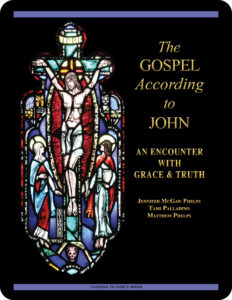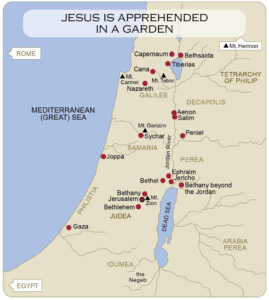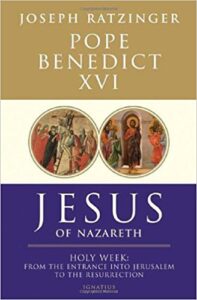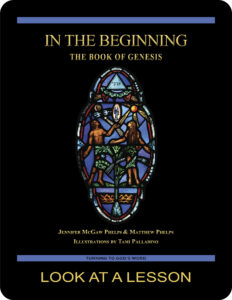 The Gospel According to John:
The Gospel According to John:
An Encounter with Grace & Truth
Lesson 21 Whom Do You Seek?
the Gospel According to John 18:1–27
Revised Standard Version Catholic Edition (RSVCE)*
New American Bible Revised Edition (NABRE)*
Catechism of the Catholic Church
ex libris (in our library)
glossary for the Gospel According to John
cross references in the Gospel According to John
next lesson: My Kingship Is Not of This World
This material coordinates with Lesson 21 on pages 111–115 in The Gospel According to John: An Encounter with Grace & Truth.
“Now Jesus did many other signs in the presence of the disciples, which are not written in this book; but these are written that you may believe that Jesus is the Christ, the Son of God, and that believing you may have life in his name.”—the Gospel According to John 20:30–31
welcome to our in-depth study of the Gospel According to John
We invite interested groups and individuals to check out the sample first lesson from this 25- lesson Turning to
lesson Turning to  God’s Word Catholic Bible study. These online study pages link to our free lesson videos, as well as to a glossary and cross references in the biblical text. Other study aids include maps, additional commentary, and prayers based on the primary Scripture in each lesson. The Gospel According to John: An Encounter with Grace & Truth has been granted an imprimatur and can be purchased from our website shop. If you have a Bible-study question or comment, click on one of the “ask us your question” or “what do you think” buttons on any online study page.
God’s Word Catholic Bible study. These online study pages link to our free lesson videos, as well as to a glossary and cross references in the biblical text. Other study aids include maps, additional commentary, and prayers based on the primary Scripture in each lesson. The Gospel According to John: An Encounter with Grace & Truth has been granted an imprimatur and can be purchased from our website shop. If you have a Bible-study question or comment, click on one of the “ask us your question” or “what do you think” buttons on any online study page.
open with prayer
It’s always wise to begin any Bible study with prayer, whether reading the Scriptures alone or meeting with others in a discussion study group. You can pray using your own words or use one of the opening prayers on our website. We especially like the following:
Lord Jesus, you promised to send your Holy Spirit
to teach us all things.
As we read and study your word today,
allow it to touch our hearts and change our lives. Amen.
let’s review—the Gospel According to John 17:1–26
In Lesson 20 And This Is Eternal Life, Jesus continues to emphasize truth, demonstrating its importance in the prayer that makes up the entire seventeenth chapter in the Gospel According to John. In this prayer, in which Jesus allows his disciples to listen in much the same way that we can listen to a conference call, Jesus explains eternal life as well as reviews the basic plan for the foundation of the Church. This section of the Fourth Gospel sometimes is referred to as the “high priestly prayer,” probably because it preceded Jesus’ sacrifice of his own life, though the only reference Jesus makes to his coming Passion occurred at the beginning of the prayer when he announces that his hour had come, something he’s previously said several times.
map notes—let’s revisit when these events are occurring
In the eighteenth chapter in the Gospel According to John, the events of Holy Week begin in earnest. At this point in the narrative, it’s worthwhile to review how the timetable used in the Fourth Gospel differs  from that used by the synoptic writers. The primary disconnect occurs in connection with Jesus’ Passion and death. The Gospel According to Matthew 26:17–36, the Gospel According to Mark 14:12–32, and the Gospel According to Luke 22:1–39 all have Jesus celebrating his Last Supper with the disciples as a Passover meal, and it’s after this that Jesus goes to the garden of Gethsemane where he’s arrested. In the eighteenth chapter in the Gospel According to John, however, the Passover hasn’t yet occurred at the time of Jesus’ arrest. To review when the events surrounding Jesus’ Passion, death, and Resurrection are occurring in the Fourth Gospel according to the Jewish liturgical calendar, refer to “The Start of Holy Week” on page 83 in The Gospel According to John: An Encounter with Grace & Truth. Click on the image (right) to enlarge the map, which appears on page 113 in the study book.
from that used by the synoptic writers. The primary disconnect occurs in connection with Jesus’ Passion and death. The Gospel According to Matthew 26:17–36, the Gospel According to Mark 14:12–32, and the Gospel According to Luke 22:1–39 all have Jesus celebrating his Last Supper with the disciples as a Passover meal, and it’s after this that Jesus goes to the garden of Gethsemane where he’s arrested. In the eighteenth chapter in the Gospel According to John, however, the Passover hasn’t yet occurred at the time of Jesus’ arrest. To review when the events surrounding Jesus’ Passion, death, and Resurrection are occurring in the Fourth Gospel according to the Jewish liturgical calendar, refer to “The Start of Holy Week” on page 83 in The Gospel According to John: An Encounter with Grace & Truth. Click on the image (right) to enlarge the map, which appears on page 113 in the study book.
 the priests & Pharisees are behaving like humans (41:29)
the priests & Pharisees are behaving like humans (41:29)
In the video for this lesson, Turning to God’s Word author Matthew Phelps  discusses the behavior of the Jewish religious authorities surrounding Jesus’ Crucifixion. This sometimes can be difficult for present-day Christians to understand. While it’s easy to view these religious leaders harshly, Matthew points out that almost everyone at one time or another has tried to rationalize an immoral action by lying about or discounting the validity of a moral teaching that conflicted with a selfish desire. Consider how this practice affects the Church. To learn more about what’s behind
discusses the behavior of the Jewish religious authorities surrounding Jesus’ Crucifixion. This sometimes can be difficult for present-day Christians to understand. While it’s easy to view these religious leaders harshly, Matthew points out that almost everyone at one time or another has tried to rationalize an immoral action by lying about or discounting the validity of a moral teaching that conflicted with a selfish desire. Consider how this practice affects the Church. To learn more about what’s behind  the actions of the Jewish religious leaders and how Jesus reacts to them, read “Dispensing with Legalities” on page114 in The Gospel According to John: An Encounter with Grace & Truth.
the actions of the Jewish religious leaders and how Jesus reacts to them, read “Dispensing with Legalities” on page114 in The Gospel According to John: An Encounter with Grace & Truth.
The Scripture ranges for the videos that accompany this Catholic Bible study match the Scripture ranges for the sets of questions in The Gospel According to John: An Encounter with Grace & Truth. You can follow along as Turning to God’s Word author Matthew Phelps discusses Lesson 21, “Whom Do You Seek?” on pages 111–115 in the study book.
throwing out the law
Until this point in the Gospel According to John, the Jewish religious leaders have focused on setting traps for Jesus that would place Jesus on the wrong side of the law. It’s no surprise that all of their efforts have been unsuccessful. Since the law is a gift given by God, it’s inconceivable to use God’s law against God. In this section of the Gospel According to John, Jesus’ enemies abandon the law altogether and begin relying on lies and deception to rid themselves of Jesus.
WHAT DO YOU THINK ABOUT the mystery surrounding John?
Throughout the Gospel According to John we’ve been presented with questions about how it is that there are a number of key events in Jesus’ life that only are recorded in the Fourth Gospel. In this section, the plot thickens when readers learn that the Evangelist apparently was in close enough standing to be admitted to the courtyard where Jesus was being questioned. Not only was John admitted, he also was able to vouch for Peter.
 ? We can assume that the Evangelist’s presence in the courtyard affords him the opportunity to report firsthand the details of Peter’s denial. What possibilities might explain the nature of John’s relationship with the high priest?
? We can assume that the Evangelist’s presence in the courtyard affords him the opportunity to report firsthand the details of Peter’s denial. What possibilities might explain the nature of John’s relationship with the high priest?
? Consider how the Evangelist might have reacted to Peter’s denial at the time it occurred.
? What might explain why the synoptic Gospels According to Matthew, Mark, and Luke record Peter’s denial, yet none of them report that Peter wasn’t the only disciple who followed Jesus after the arrest in the garden?
? Consider whether the Evangelist’s mention of his own location immediately following Jesus’ arrest makes his account of events more or less credible.
 agony—you could look it up in our archives
agony—you could look it up in our archives
Most Christians understand Jesus’ sorrow and distress, but the original meaning of the word agony has changed over time. To learn more about agony as a type of contest or competition, read Lost in Translation, an online column in which Turning to God’s Word author Matthew Phelps helps readers connect with ideas expressed in the original languages of the Scriptures. You can learn more in Jesus’ Passion: The Story of Redemptive Suffering, which is based on the biblical passages that are the foundation of the film The Passion of the Christ. New entries are posted every Monday throughout the year, and past entries of Lost in Translation are archived on our website. Contact us if you’d like to receive Lost in Translation by email every week. During the Lenten season, you also can check out Jesus’ Passion: The Story of Redemptive Suffering, which isn’t available at other times of the year.
website. Contact us if you’d like to receive Lost in Translation by email every week. During the Lenten season, you also can check out Jesus’ Passion: The Story of Redemptive Suffering, which isn’t available at other times of the year.
 the popes inspire us—another mystery
the popes inspire us—another mystery
In the papal quote “A Mystery” on page 115 in The Gospel According to John: An Encounter with Grace & Truth, Pope Benedict XVI ponders an important difference between Peter’s repentance for his denial of Jesus and Judas’ repentance for his betrayal. Read the entire papal quote for the conclusion by Pope Benedict XVI that this difference offers Christians an invitation never to despair of God’s mercy.
betrayal & denial
Many people find it extremely difficult to make a distinction between Judas’ betrayal of Jesus and Peter’s denial of Jesus, both of which are described in the eighteenth chapter in the Gospel According to John. You can learn more about the distinction between these terms by reading the vocabulary box on page 115 in The Gospel According to John: An Encounter with Grace & Truth.
more about Judas & Peter
In a reflection for Holy Week, Abbot Benedict Neenan, O.S.B., of Conception Abbey points out: “Betrayal and denial: Jesus foretells these acts of Judas and Peter at the Last Supper. The people closest to Jesus were no more loyal or faithful to him than those who plotted against him and those who would call out, ‘Crucify him! Crucify him!’ the next day. … The fact that Judas’ betrayal will bring about the final and complete glorification of Jesus — the fulfillment of his mission on earth — shows that out of the most despicable deeds, God can accomplish his greatest work.” It’s important to keep in mind that throughout the events of his Passion and death, Jesus remains in control of the outcome. Everything that occurs happens for the salvation of humanity.
ex libris—learn more about Jesus’ Passion, death & Resurrection
 In Jesus of Nazareth: Holy Week, the second of a three-part series based on information about Jesus found in the
In Jesus of Nazareth: Holy Week, the second of a three-part series based on information about Jesus found in the Gospels, Pope Benedict XVI looks at the decisive events and sayings that are the focus of Jesus’ last week on earth. The Scripture covered begins with Jesus’ entrance into Jerusalem and continues through the time of his Resurrection. Read excerpts and learn more about all three volumes of Jesus of Nazareth and other works related to Bible study at ex libris—main bookshelf.
Gospels, Pope Benedict XVI looks at the decisive events and sayings that are the focus of Jesus’ last week on earth. The Scripture covered begins with Jesus’ entrance into Jerusalem and continues through the time of his Resurrection. Read excerpts and learn more about all three volumes of Jesus of Nazareth and other works related to Bible study at ex libris—main bookshelf.
for additional reflection
When the word Passion is capitalized, it refers to Jesus’ suffering leading to his death. You can learn more about the word by reading “Passion” on page 112 in The Gospel According to John: An Encounter with Grace & Truth. The following questions are designed to help readers begin to form their own thoughts and ideas related to the Gospel According to John 18:1–27. For more reflection questions, refer to the introduction to Lesson 21 on page 111 in The Gospel According to John: An Encounter with Grace & Truth.
 ? Consider whether the present-day idea of passion as a strong emotional reaction might water down the way in which Christians view Jesus’ suffering.
? Consider whether the present-day idea of passion as a strong emotional reaction might water down the way in which Christians view Jesus’ suffering.
? How might the present-day idea of passion as a strong emotional reaction strengthen the way in which Christians view Jesus’ suffering?
? Does knowledge that the word “agony” refers to a competitive struggle make it easier or more difficult to relate to Jesus suffering?
? What gifts has Jesus given to the Church that can help Christians understand his Passion?
? In what ways do you willingly participate in Jesus’ Passion?
a clarification in the study book
Question 2 in The Gospel According to John: An Encounter with Grace & Truth will include reference to the Catechism of the Catholic Church to clarify teaching about original sin. The question is based on the Gospel According to John 18:1–2, which also is the basis for Question 1. You can learn more about Adam and about original sin in Lesson 3 The Fall of Adam & Eve in the Turning to God’s Word Catholic Bible study In the Beginning: The Book of Genesis. The updated Question 2 in The Gospel According to John: An Encounter with Grace & Truth now reads:
Adam and about original sin in Lesson 3 The Fall of Adam & Eve in the Turning to God’s Word Catholic Bible study In the Beginning: The Book of Genesis. The updated Question 2 in The Gospel According to John: An Encounter with Grace & Truth now reads:
Question 2 Jesus sometimes is referred to as the new Adam. According to the Letter to the Romans 5:12–18, how is it that all people are implicated in Adam’s sin? If necessary, refer to paragraph 404 in the Catechism of the Catholic Church to explain how the personal sin of Adam and Eve is transmitted to all humanity.
read the Catechism—original sin
Many people have difficulty with the concept of original sin. Paragraph 404 in the Catechism of the Catholic Church offers this explanation about how original sin became part of our human nature:
 404 How did the sin of Adam become the sin of all his descendants? The whole human race is in Adam as “one body of one man.” By this “unity of the human race” all men are implicated in Adam’s sin, as all are implicated in Christ’s justice. Still, the transmission of original sin is a mystery that we cannot understand. But we do know by Revelation that Adam had received original holiness and justice not for himself alone, but for all human nature. By yielding to the tempter, Adam and Eve committed a personal sin, but this sin affected the human nature that they would then transmit in a fallen state. It is a sin which will be transmitted by propagation to all mankind, that is, by the transmission of a human nature deprived of original holiness and justice. And that is why original sin is call “sin” only in an analogical sense: it is a sin “contracted” and not “committed” — a state and not an act.
404 How did the sin of Adam become the sin of all his descendants? The whole human race is in Adam as “one body of one man.” By this “unity of the human race” all men are implicated in Adam’s sin, as all are implicated in Christ’s justice. Still, the transmission of original sin is a mystery that we cannot understand. But we do know by Revelation that Adam had received original holiness and justice not for himself alone, but for all human nature. By yielding to the tempter, Adam and Eve committed a personal sin, but this sin affected the human nature that they would then transmit in a fallen state. It is a sin which will be transmitted by propagation to all mankind, that is, by the transmission of a human nature deprived of original holiness and justice. And that is why original sin is call “sin” only in an analogical sense: it is a sin “contracted” and not “committed” — a state and not an act.
the best Catholic commentary about Scripture
To find out more about how Church teaching is supported by Scripture passages in The Gospel According to John: An Encounter with Grace & Truth, check out the Index of Citations in the Catechism of the Catholic Church. Links (Revised Standard Version Catholic Edition [RSVCE*]) to the primary Scripture passages in the lesson and relevant paragraphs in the Catechism are provided here. Not every passage in the biblical text for this study is referenced in a Catechism paragraph, however.
the Gospel According to John 18:4–6—paragraph 609
the Gospel According to John 18:11—paragraph 607
the Gospel According to John 18:12—paragraph 575
the Gospel According to John 18:20—paragraph 586
ways our glossary might prove helpful
In addition to providing extra information about geographical locations, our glossary also points out  persons and places mentioned in the biblical text under multiple names or spellings. If you can remember a name but aren’t sure in which lesson it shows up, you can find it in the glossary, which lists every proper noun that appears in the primary biblical text for The Gospel According to John: An Encounter with Grace & Truth.
persons and places mentioned in the biblical text under multiple names or spellings. If you can remember a name but aren’t sure in which lesson it shows up, you can find it in the glossary, which lists every proper noun that appears in the primary biblical text for The Gospel According to John: An Encounter with Grace & Truth.
to learn more, read more Scripture
If you’re having difficulty with a passage of Scripture, it can be helpful to read the relevant  cross references—but looking these up can take time. To make that easier, we’ve compiled the cross references from the Revised Standard Version Second Catholic Edition (RSV2CE)—the translation that we reprint in our study books. That list can be found at the top of every online study page accompanying this study, and it includes links to each of the cross references in the primary biblical text for The Gospel According to John: An Encounter with Grace & Truth.
cross references—but looking these up can take time. To make that easier, we’ve compiled the cross references from the Revised Standard Version Second Catholic Edition (RSV2CE)—the translation that we reprint in our study books. That list can be found at the top of every online study page accompanying this study, and it includes links to each of the cross references in the primary biblical text for The Gospel According to John: An Encounter with Grace & Truth.
don’t forget about our indexes & extra online material

 If you’re trying to locate information about a specific Scripture passage, you can look it up in the index at the back of the study book or sample lesson. If you want to find a particular commentary, you can look up its title in the topics index. To learn more about another book of the Bible for which there’s a Turning to God’s Word study, visit the online study directories to read the commentaries and watch any accompanying videos. Finally, if you have a question or would like to make a comment about any of our studies, you can use one of the “ask us your question” or “what do you think” buttons to email our authors.
If you’re trying to locate information about a specific Scripture passage, you can look it up in the index at the back of the study book or sample lesson. If you want to find a particular commentary, you can look up its title in the topics index. To learn more about another book of the Bible for which there’s a Turning to God’s Word study, visit the online study directories to read the commentaries and watch any accompanying videos. Finally, if you have a question or would like to make a comment about any of our studies, you can use one of the “ask us your question” or “what do you think” buttons to email our authors.
ex libris—Church documents & books about religious topics
You can find links to magisterial documents referred to in Turning to God’s Word Catholic Bible studies  at ex libris—magisterial documents. This page includes a listing of significant recent encyclicals as well as a number of historical Church documents. Recommended books related to Scripture study can be found at ex libris—main bookshelf.
at ex libris—magisterial documents. This page includes a listing of significant recent encyclicals as well as a number of historical Church documents. Recommended books related to Scripture study can be found at ex libris—main bookshelf.
wondering how to pronounce some of these words?
The following link is to a reading from the New International Version (NIV) Bible. To listen, click on the audio icon above the printed text. Although not taken from the translations used in our study materials, the NIV reading provides an audio guide to pronunciation of words in this lesson’s primary biblical text. A close online version of the translation of the Bible used in Catholic liturgy in the United States as well as an audio guide for daily Mass readings for the current month can be found on the website of the United States Conference of Catholic Bishops (USCCB).
the Gospel According to John 18:1–27 (NIV)
 close with Bible-based prayer related to this lesson
close with Bible-based prayer related to this lesson
Many of our Catholic study groups like to conclude their discussions with a prayer based on the scriptural focus of their lesson, and some participants include Scripture-specific prayer in their individual study. If you’re uncomfortable composing your own Bible-based prayers, you can follow our four easy steps, or you can use the following prayer based on this lesson’s text from the Gospel According to John.
God our Father, you sent your Son
to show us how to love.
Help us to avoid denying our faith when we’re faced
with criticism and misunderstanding
from those who don’t know you.
We ask this through Jesus Christ, our Lord. Amen.
Lesson 22 My Kingship Is Not of This World—the Gospel According to John 18:28—19:16
Lesson 20 And This Is Eternal Life—the Gospel According to John 17:1–26
you also may like our study of the book of Genesis
 The first seven lessons of In the Beginning: The Book of Genesis, a 28-lesson Catholic Bible study with an imprimatur, provide an in-depth look at the very earliest biblical history—including the two accounts of Creation, events surrounding the Fall of Adam and Eve, the relationship between Cain and Abel, and the baptismal foreshadowing present in the account of Noah and the Flood. Remaining lessons look at lives of the patriarchs Abraham, Isaac, Jacob, and Joseph. Click on the book’s cover to view a sample lesson.
The first seven lessons of In the Beginning: The Book of Genesis, a 28-lesson Catholic Bible study with an imprimatur, provide an in-depth look at the very earliest biblical history—including the two accounts of Creation, events surrounding the Fall of Adam and Eve, the relationship between Cain and Abel, and the baptismal foreshadowing present in the account of Noah and the Flood. Remaining lessons look at lives of the patriarchs Abraham, Isaac, Jacob, and Joseph. Click on the book’s cover to view a sample lesson.
start a Turning to God’s Word Bible study
 Thank you for your interest in The Gospel According to John: An Encounter with Grace & Truth.
Thank you for your interest in The Gospel According to John: An Encounter with Grace & Truth.  Information about beginning a Turning to God’s Word Bible study can be found at start a Bible study. Tami, Matthew, and I are available to answer questions and offer support. Contact us if you’d like to start one of our studies or have your schedule listed with other TtGW study groups on our website. —Jennifer
Information about beginning a Turning to God’s Word Bible study can be found at start a Bible study. Tami, Matthew, and I are available to answer questions and offer support. Contact us if you’d like to start one of our studies or have your schedule listed with other TtGW study groups on our website. —Jennifer
*There are seven deuterocanonical books in the Old Testament—the Books of Tobit, Judith, Wisdom, Sirach, Baruch, and First and Second Maccabees, as well as some passages in the Books of Esther and Daniel. Protestants usually refer to these works as “apocryphal,” a word that means “outside the (Protestant) canon” because they’re excluded from most Protestant Bibles. The word “deuterocanonical” means “second canon”; Catholics use that word to refer to any section of the Catholic Old Testament for which there are no extant, or existing, Hebrew manuscripts. All of the deuterocanonical books appear in the Septuagint, the earliest remaining versions of which date to the 1st century B.C. This Greek translation of the Old Testament was in common use by Jews at the time of Jesus—but the same books aren’t found in existing Hebrew manuscripts, which aren’t as old as the oldest version of the Septuagint. Learn more by reading How Do Catholic & Protestant Bibles Differ?
Turning to God’s Word printed Bible studies use the 2006 Revised Standard Version Second Catholic Edition (RSV2CE) translation for all Scripture references except those to the Psalms, which are taken from The Abbey Psalms and Canticles, prepared by the Benedictine monks of Conception Abbey and published in 2020 by the United States Conference of Catholic Bishops (USCCB). All Scripture links for the online study pages for The Gospel According to John: An Encounter with Grace & Truth are to the 1966 Revised Standard Version Catholic Edition (RSVCE) translation. The New International Version (NIV) audio recordings follow the same chapter and verse numbering as the RSV Catholic translations, but the NIV translation doesn’t include the deuterocanonical books and passages.
The 1966 RSVCE uses archaic pronouns and verb forms such as “thee,” “thou,” “didst” in the Psalms and in direct quotations attributed to God. The 2006 RSV2CE replaces those with more accessible English. The few significant translation changes in the RSV2CE include rendering almah as “virgin” in the Book of Isaiah 7:14 and restoring the term “begotten” in the Gospel According to John 3:16.
Numbering varies for some passages in this Bible study. Turning to God’s Word studies (print and digital) follow the numbering in the Revised Standard Version Catholic translations (RSV2CE and RSVCE). Discrepancies in the New American Bible Revised Edition (NABRE) are noted in the Index of Scripture Citations in the study book and the online sample.
 You can learn more about the Psalms by viewing a sample lesson from the Turning to God’s Word Catholic Bible study Sing a New Psalm: Communicating with God Through the Prayers of the Church—Volume I: Lauds & Vespers. The second part of that study, Sing a New Psalm: Communicating with God Through the Prayers of the Church—Volume II: Vigils, Day Prayer & Compline, is scheduled for publication in 2025. Some verse numbers may vary in different translations of the Psalms.
You can learn more about the Psalms by viewing a sample lesson from the Turning to God’s Word Catholic Bible study Sing a New Psalm: Communicating with God Through the Prayers of the Church—Volume I: Lauds & Vespers. The second part of that study, Sing a New Psalm: Communicating with God Through the Prayers of the Church—Volume II: Vigils, Day Prayer & Compline, is scheduled for publication in 2025. Some verse numbers may vary in different translations of the Psalms.
